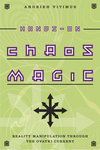What’s The Fuss About Chaos Magic?

For some time, back in the 1970s, I had been ordering items from an odd occult shop in Great Britain. I say "odd" because their catalog made rather quirky claims and had products that nobody else carried, often with the "warning" that only their products were "official" (whatever that meant!). One of the things they described in their catalog was something called Chaos Magic. Over time, I started to see mentions of it in various newsletters and magazines from England, so toward the end of the decade I ordered a book that was simply called Liber Null by someone named Peter J. Carroll.
At that time, Chaos Magic was beginning to explode in popularity in Europe and the UK, as was Wicca. For a time, it even appeared that Chaos Magic would overshadow Wicca, although it never quite got that far. Some of the finest, most creative, and original magicians in the world were practicing this form of magic. In the US, few people had heard of it. I was fascinated by it and even wrote some articles for a small journal dedicated to Chaos Magic called Thanateros.
It wasn't until 1986 that Liber Null was published in the US, combined with another book by Carroll, Psychonaut. Unfortunately, many of the people who were intrigued by it, typically younger men, saw it not as a new direction, but as an easy way to do magic with no practice, study, or training. Frankly, for many it was an excuse for self-indulgent silliness and egotism. As a result (and combined with a lack of support in the form of writing, newsletters, and journals), it just didn't catch on in the US.
But it didn't go away. Instead, the number of dedicated practitioners in Europe and the UK grew and grew. Although not "underground," books published about it were few in number. I remember being asked to review a manuscript on Chaos Magic some time ago. It was entirely invented by the author and had nothing to do with Chaos Magic practiced all over the world; instead, it was based on an unpublished novel the author had written! Thankfully, the manuscript was never published. Unfortunately, some of the books that have been published on Chaos Magic have not been very good.
The basic thrust of Chaos Magic is to avoid all of the additions that have been put onto magic over thousands of years and use the minimum effort that will provide maximum results. This requires achieving a very focused state of mind, called the "Gnostic state" or a trance state. You focus on your magical goal while in this state and at the right moment you let it go and forget it. This puts the goal into your subconscious mind and allows the subconscious to do whatever is necessary to make the magic happen.
Llewellyn (wisely, in my opinion) has waited until now to publish a book on the subject, Hands-On Chaos Magic. Most of the books on this topic have been very theoretical or described actual practices rather superficially. Hands-On Chaos Magic focuses almost entirely on practical exercises and real-life experience, rather than dwelling too long on theoretical questions. The author encourages you to, above all, use what works based on your own hands-on experiments. I recommend this book to those who want to learn about Chaos Magic, practice it, or expand their knowledge of these techniques step by step.
Don't Forget the Basics
An important key to success with Chaos Magic or any other form of magic is to learn the basics. A great place to start is Practical Magic for Beginners by Brandy Williams. This covers some of the basic techniques and concepts without focusing on any philosophy or a particular tradition. And if you do have some experience, it's a great refresher course on such things as energy work, divination, and psychic development.

About Donald Michael Kraig
Related Products


is subject to certain Terms and Conditions